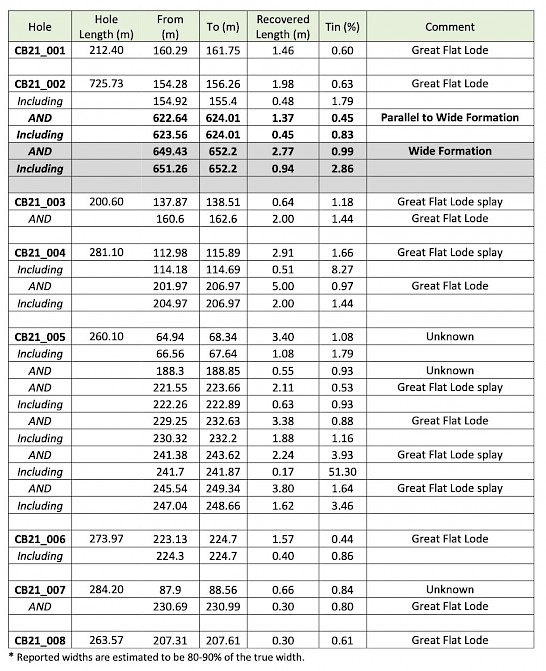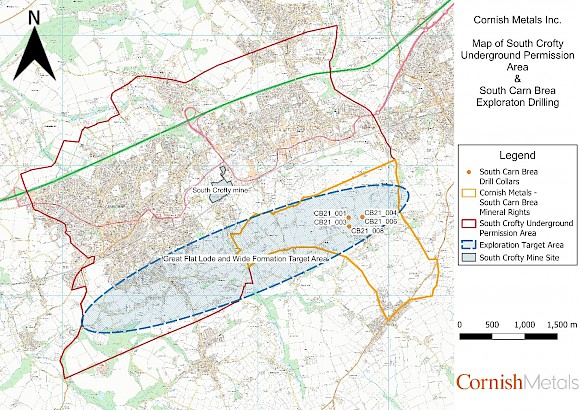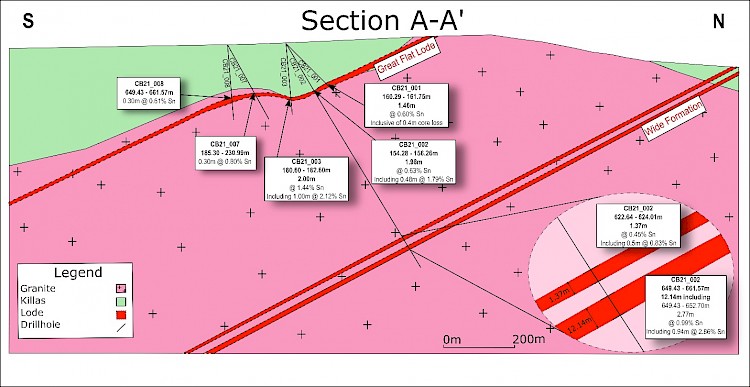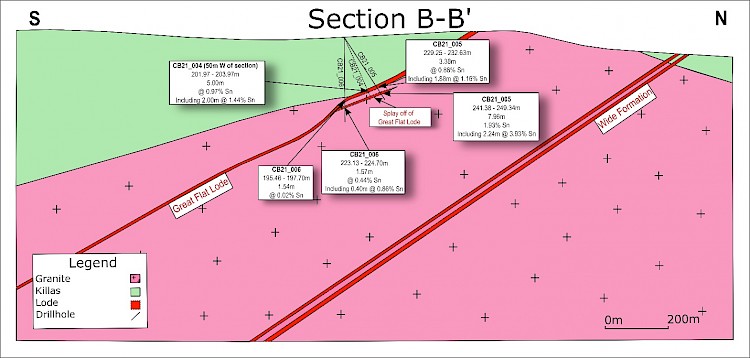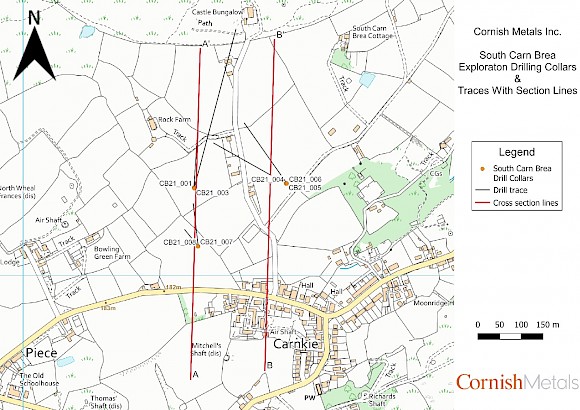Related Document
Cornish Metals Inc. (TSX-V/AIM: CUSN) (“Cornish Metals” or the “Company”) is pleased to report drill results from eight drill holes drilled in the Carn Brea South exploration area, located along the southern boundary of the South Crofty underground permission area (Figure 1). The drill holes confirmed up-dip, near-surface, extensions of the historic Great Flat Lode and discovered tin mineralisation in a new target called the “Wide Formation”, inferred to lie parallel to, north of, and beneath the Great Flat Lode.
Highlights
Drilling was conducted along the southern boundary of South Crofty – an area easily accessible from existing mine infrastructure;
- New discovery of high-grade tin mineralisation in the Wide Formation (Figure 2);
- CB21_002 2.77 metres (“m”) grading 0.99% tin (Figure 2) within a 12.14m wide zone of strong alteration and disseminated tin mineralisation;
- All eight drill holes intersected tin mineralization;
- Multiple high-grade tin intersects from the Great Flat Lode (Figures 2, Figure 3 and Figure 4) and related mineralised structures, including:
- CB21_003 2.00m grading 1.44% tin
- CB21_004 2.91m grading 1.66% tin
- And 5.00m grading 0.97% tin
- CB21_005 3.04m grading 1.08% tin
- And 2.24m grading 3.93% tin
- And 3.80m grading 1.64% tin
- Table 1 (below) presents all significant intersects.
Richard Williams, CEO of Cornish Metals, stated: “The Wide Formation has been interpreted to exist from exploration drilling conducted in the 1960s but has never been followed up until now. Discovering a new high-grade zone of tin mineralisation in the middle of a historic mining district is a tremendous outcome, and again demonstrates the exploration potential of the region. The Great Flat Lode, which lies above the Wide Formation, was mined historically over a five kilometre (“km”) strike length, so we believe we have a very compelling target to explore within and immediately adjacent to the South Crofty Underground Permission area. We look forward to the next phase of drilling to determine the extent of this discovery.
”The shallow, high-grade tin intersects from the Great Flat Lode represent an opportunity to define nearby and near surface Mineral Resources to complement those we have already identified at South Crofty.”
GEOLOGY AND MINERALISATION
The geology in the Carn Brea South exploration area is identical to that at South Crofty, comprising metasediments (locally termed “killas”) which overlie an intrusive granite body. The mineralised structures of interest encountered are the Great Flat Lode and the Wide Formation, descriptions of which are as follows:
The Great Flat Lode mineralisation occurs as a blue tourmaline-rich lode with quartz (occasionally brecciated) hosting disseminated cassiterite mineralisation throughout. The mineralised structure, which appears to lie along the metasedimentary/granite boundary, has a strong alteration halo extending many metres above and below the structure. Downhole widths of the mineralised lodes vary between >4m to <15m. The blue tourmaline host to the mineralisation is similar to the predominant mineralised structures at South Crofty mine, namely No. 8 and Roskear A lodes. The Great Flat Lode was extensively mined for tin in the 1800s in several mines over a five kilometre strike length and from depths ranging from surface to 680 metres below the surface.
The mineralisation of the ‘Wide Formation’ structure is also predominantly blue tourmaline with disseminated cassiterite, hosted within a siliceous tourmaline altered granite. The cassiterite is mostly hosted within chlorite-rich, quartz-chlorite veins which overprint the interpreted earlier blue tourmaline lode structure. No mining has ever been carried out on the Wide Formation.
TECHNICAL INFORMATION
Drilling at Carn Brea South was performed by Priority Drilling Company Ltd using an Atlas Copco CS14 Diamond Drill Rig. The shallower Great Flat Lode mineralised zones were drilled in HQ (96.1 millimetre (‘mm’) diameter) to recover 72.8mm diameter drill core. The deeper Wide Formation intersection was drilled in NQ (76 mm diameter) to recover a 48mm diameter drill core. Core recovery was greater than 95%. The core was logged, split via core saw, and sampled by Cornish Metals personnel. The samples, comprising half core, were sent for assay at ALS Minerals, Loughrea, Ireland. Sample preparation involved crushing to 70% less than 2mm, riffle split and pulverised to 85% less than 75 microns. The analytical method used for copper, tin, tungsten, zinc and arsenic was X-ray florescence (XRF) following a lithium borate fusion. A multi-element 4 Acid Digestion ICP-AES analysis was also carried out to further characterise the mineralisation and alteration assemblages. Overlimit assays on silver were carried out using a 3-acid digest and a HCl leach ICP AES analysis. Comprehensive Quality Assurance / Quality Control programme using standards, duplicates and blanks was included within the sampling programme.
The technical information in this news release has been compiled by Mr. Owen Mihalop who has reviewed and takes responsibility for the data and geological interpretation. Mr. Mihalop (MCSM, BSc (Hons), MSc, FGS, MIMMM, CEng) is Chief Operating Officer for Cornish Metals Inc. and has sufficient experience relevant to the style of mineralisation and type of deposit under consideration and to the activity which he is undertaking to qualify as a Competent Person as defined under the JORC Code (2012) and as a Qualified Person under NI 43-101. Mr. Mihalop consents to the inclusion in this announcement of the matters based on his information in the form and context in which it appears.
ABOUT CORNISH METALS
Cornish Metals is a dual-listed company (AIM and TSX-V : CUSN) focused on advancing the South Crofty high-grade, underground tin project through to delivery of a Feasibility Study, as well as exploring its additional mineral rights, all located in Cornwall, South West England. The former producing South Crofty tin mine is located beneath the towns of Pool and Camborne, and closed in 1998 following over 400 years of continuous production. Since acquiring the project in 2016, Cornish Metals has completed and published maiden NI 43-101 Mineral Resources for South Crofty using the vast archive of historical production data and more recent drilling completed between 2007 and 2013. Additionally, Cornish Metals has undertaken extensive pilot-scale water treatment trials and successfully applied for and received the necessary environmental permits to abstract, treat and discharge mine water in order to dewater the mine. Planning permissions for the operation of the mine and re-development of the surface facilities have been secured and construction of the water treatment plant is currently well underway. The dewatering pumps, variable speed drives and new high-voltage power supply have been delivered to the site and dewatering of the mine is expected to commence at the end of Q2 this year.
An updated Mineral Resource was completed in June 2021 as summarised below:
|
South Crofty Summary (JORC 2012) Mineral Resource Estimate |
|||||
|
Area |
Classification |
Mass (‘000 tonnes) |
Grade |
Contained Tin / Tin Equivalent (‘000 tonnes) |
Increase in contained Tin / Tin equivalent from 2016 MRE |
|
Lower Mine |
Indicated |
2,084 |
1.59% Sn |
33 |
10.2% |
|
Inferred |
1,937 |
1.67% Sn |
32 |
129.8% |
|
|
|
|||||
|
Upper Mine |
Indicated |
277 |
1.01% SnEq |
3 |
9.5% |
|
Inferred |
493 |
0.93% SnEq |
5 |
8.0% |
|
The Mineral Resource Estimate for South Crofty (see news release dated June 9, 2021), is available in a report titled the “South Crofty Tin Project Mineral Resource Update”, dated June 7, 2021, authored by Mr. N. Szebor, CGeol (London), EuroGeol, FGS, of AMC Consultants (UK) Ltd, can be accessed on the Company’s SEDAR page.
For additional information please contact:
In North America:
Irene Dorsman at (604) 200 6664.
In UK:
SP Angel Corporate Finance LLP Tel: +44 203 470 0470
(Nominated Adviser & Joint Broker) Richard Morrison
Charlie Bouverat
Grant Barker
H & P Advisory Limited Tel: +44 207 907 8500
(Joint Broker) Matthew Hasson
Andrew Chubb
Ernest Bell
BlytheRay Tel: +44 207 138 3204
(Financial PR/IR-London) Tim Blythe tim.blythe@blytheray.com
Megan Ray megan.ray@blytheray.com
ON BEHALF OF THE BOARD OF DIRECTORS
“Richard D. Williams”
Richard D. Williams, P.Geo
Market Abuse Regulation (MAR) Disclosure
The information contained within this announcement is deemed by the Company to constitute inside information pursuant to Article 7 of EU Regulation 596/2014 as it forms part of UK domestic law by virtue of the European Union (Withdrawal) Act 2018 as amended.
Neither the TSX Venture Exchange nor its Regulation Services Provider (as that term is defined in the policies of the TSX Venture Exchange) accepts responsibility for the adequacy or accuracy of this release.
Caution regarding forward looking statements
This news release contains "forward-looking statements". Forward-looking statements, while based on management's best estimates and assumptions at the time such statements are made, are subject to risks and uncertainties that may cause actual results to be materially different from those expressed or implied by such forward-looking statements, including but not limited to: risks related to receipt of regulatory approvals, risks related to general economic and market conditions; risks related to the COVID-19 global pandemic and any variants of COVID-19 which may arise; risks related to the availability of financing; the timing and content of upcoming work programmes; actual results of proposed exploration activities; possible variations in Mineral Resources or grade; failure of plant, equipment or processes to operate as anticipated; accidents, labour disputes, title disputes, claims and limitations on insurance coverage and other risks of the mining industry; changes in national and local government regulation of mining operations, tax rules and regulations.
Although Cornish Metals has attempted to identify important factors that could cause actual results to differ materially from those contained in forward-looking statements, there may be other factors that cause results not to be as anticipated, estimated or intended. There can be no assurance that such statements will prove to be accurate, as actual results and future events could differ materially from those anticipated in such statements. Accordingly, readers should not place undue reliance on forward-looking statements. Cornish Metals undertakes no obligation or responsibility to update forward-looking statements, except as required by law.
Figure 1 – Map showing the collar locations of the Carn Brea South drill holes in relation to the South Crofty underground permission area
Figure 2. Section (looking west) of drillholes CB21_001, CB21_002 and CB21_003
Figure 3. Section (looking west) of drillholes CB21_004, CB21_005 and CB21_006
Figure 4. Plan map showing the orientation of the cross sections shown in Figures 2 and 3
Appendix
“alteration halo” means a border of minerals produced by hydrothermal alteration in the rock surrounding a vein
“cassiterite” means a tin oxide mineral which is the principal source for tin metal
"Cu" means Copper
"grade(s)" means the quantity of ore or metal in a specified quantity of rock
"Indicated Mineral Resource" is that part of a Mineral Resource for which quantity, grade or quality, densities, shape and physical characteristics are estimated with sufficient confidence to allow the application of mining, processing, metallurgical, infrastructure, economic, marketing, legal, environmental, social and governmental factors to support mine planning and evaluation of the economic viability of the deposit. Geological evidence is derived from adequately detailed and reliable exploration, sampling and testing and is sufficient to assume geological and grade or quality continuity between points of observation. An Indicated Mineral Resource has a lower level of confidence than that applying to a Measured Mineral Resource and may only be converted to a probable mineral reserve.
"Inferred Mineral Resource" is that part of a Mineral Resource for which quantity and grade or quality are estimated on the basis of limited geological evidence and sampling. Geological evidence is sufficient to imply but not verify geological and grade or quality continuity. An Inferred Mineral Resource has a lower level of confidence than that applying to an Indicated Mineral Resource and must not be converted to a mineral reserve. It is reasonably expected that the majority of Inferred Mineral Resources could be upgraded to Indicated Mineral Resources with continued exploration. An Inferred Mineral Resource is based on limited information and sampling gathered through appropriate techniques from locations such as outcrops, trenches, pits, workings and drill holes.
"JORC Code" means the 2012 edition of the Australasian Code for Reporting of Exploration Results, Mineral Resources and Ore Reserves prepared by the Joint Ore Reserves Committee of the Australasian Institute of Mining and Metallurgy, Australian Institute of Geoscientists and Minerals Council of Australia. The JORC Code is an acceptable foreign code for purposes of NI 43-101.
"Lodes" means a vein of metal ore in the earth
"MRE" means Mineral Resource Estimate
"Mt" means million tonnes
“NI 43-101” means National Instrument 43-101 – Standards of Disclosure for Mineral Projects issued by the Canadian Securities Administrators, which provides standards of disclosure of scientific and technical information regarding mineral projects
“Sn” means Tin
“tourmaline” means the crystalline silicate mineral group that occurs as prismatic crystals in granitic and other rocks

